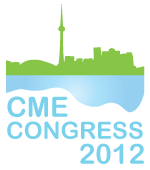Melinda Somasekhar (Temple University School of Medicine); Alfred Bove (Temple University School of Medicine); Chris Rausch (Temple University School of Medicine); Arnold Meyer (Temple University School of Medicine)
Synopsis
Through the use of a developmental model based on appropriate selection of a CME topic and analysis of specific practice change indicators, it is possible to determine the likelihood that a CME intervention will produce significant changes in physician performance. By identifying interventions with a higher likelihood of producing practice-related changes, measurement of outcomes can be achieved using more simplistic and less costly methodologies.
Abstract
Cost related to higher-level outcomes measurement is often prohibitable for smaller, less well-funded CME programs. It is possible to overcome financial and participant-related barriers to the measurement of Level 5 outcomes, change in physician performance. The Temple University School of Medicine’s Department of CME developed a model for determining the likelihood of a CME intervention to produce significant changes in physician performance using simplistic and cost-effective measurement tools. Appropriate selection of the CME topic and specific practice change indictors drives this model. This developmental model starts with careful consideration of the topic and intended/needed/recommended changes in practice. Multiple factors are considered during the selection/decision making process 1) Will the intended change(s) have a substantial impact on current practice. 2) Is there general support for the intended practice change(s) (well supported by clinical data, specialty organization/government recommendations, expert opinion, etc)? 3) Will physicians readily understand and accept the justification for the intended change(s)? 4) Is there strong motivation on the part of physicians to implement the intended change(s) (system pressure, media pressure, financial pressure, patient pressures, safety pressures, etc)? 5) Is the intended change(s) relatively easy to implement within any type of system of practice? If the answer is yes to each of these questions, then there is a higher likelihood that the intended practice-related change(s) will occur and such change can be measured using more simplistic and less costly methodology
Declaration
Authors have nothing to disclose.





